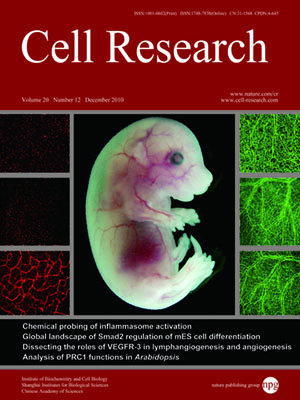
Volume 20, No 12, Dec 2010
ISSN: 1001-0602
EISSN: 1748-7838 2018
impact factor 17.848*
(Clarivate Analytics, 2019)
Volume 20 Issue 12, December 2010: 1319-1331
ORIGINAL ARTICLES
VEGFR-3 ligand-binding and kinase activity are required for lymphangiogenesis but not for angiogenesis
Luqing Zhang1,*, Fei Zhou1,*, Wencan Han1,*, Bin Shen1, Jincai Luo2, Masabumi Shibuya3 and Yulong He1
1Laboratory of Vascular and Cancer Biology, MOE Key Laboratory for Model Animal and Disease Study, Model Animal Research Institute, Nanjing University, 12 Xue Fu Road, Nanjing 210061, China
2Laboratory of Vascular Biology, Institute of Molecular Medicine, Peking University, Beijing 10087, China
3Department of Molecular Oncology, Tokyo Medical and Dental University, Tokyo 113-8519, Japan
Correspondence: Yulong He,(yhe20005@yahoo.com)
Although VEGFR-3 deficiency disrupts blood vascular development during early embryogenesis, the underlying mechanism was not clear. To characterize its function in angiogenesis and lymphangiogenesis, we employed two genetically modified mouse models in this study, targeting the coding region for the ligand-binding domain (
Vegfr3ΔLBD) or the tyrosine kinase domain with an inactivation point mutation (
Vegfr3TKmut). We show that lymphatic growth was disrupted in
Vegfr3ΔLBD/ΔLBD and
Vegfr3TKmut/TKmut mice, but blood vessels developed normally in both embryo and yolk sac. Interestingly, in
Vegfr3ΔLBD/ΔLBD but not
Vegfr3TKmut/TKmut mice, lymph sac was present but there was lack of lymphangiogenic sprouting. We further demonstrate that both the wild-type and mutant forms of VEGFR-3 could form heterodimers with VEGFR-2, and decreased the level of phospho-VEGFR-2 and the downstream phospho-Erk1/2 in endothelial cells when they were treated with VEGF-A. These findings indicate that signaling mediated via VEGFR-3 activation by its cognate ligands (VEGF-C/-D) is not required for angiogenesis, and that VEGFR-3 may play a role in this process by modulating VEGFR-2-mediated signals.
Cell Research (2010) 20:1319-1331. doi:10.1038/cr.2010.116; published online 10 August 2010
FULL TEXT | PDF
Browse 2262


